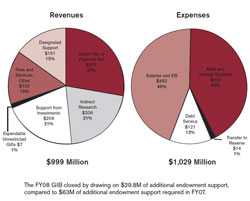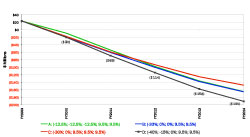
| Vol.
XXI No.
3 January / February 2009 |
| contents |
| Printable Version |
An Integrated Approach to MIT's Financial Future
Every day we are reminded in news reports and personal conversations about the world’s financial turmoil and the hardships it has brought upon individuals and institutions. As you know from faculty meetings and our letters to the community, MIT is not immune from this turbulence. As of the end of December 2008, we estimated the value of the MIT endowment had dropped by approximately 25% since June 30, 2008. We anticipate a reduction of closer to 30% by the end of this fiscal year if the trends of the fall and winter do not dramatically improve or worsen. For this reason the Institute must prepare to operate in an environment where the value of our endowment is closer to $7 billion, rather than its June 30th value of $10 billion.
A decrease of this magnitude means that budget revenues from endowment payout alone will drop by approximately $150 million (assuming a 5% payout), and that we will have to decrease our expenses by a corresponding amount.
I have been encouraged by the many faculty, students, and staff who have already shared ideas about how to make MIT stronger while reducing costs, and who have expressed their confidence in our ability to weather this financial storm. We all share the conviction that this is an opportunity for MIT to demonstrate its deepest strengths as a community of innovative problem solvers.
A revenue reduction of $150 million calls for a careful and methodical approach. We are fortunate that MIT is in a relatively strong position to accomplish these reductions because of recent developments in our financial planning processes and policies [see May 2008 MIT Faculty Newsletter]. With the help of the heads of academic and administrative units, we are operating from a balanced budget this fiscal year 2009 (FY09). In addition, our endowment payout policy smoothes the effects of market volatility over several years. However, with a potentially long period of economic recession ahead, we cannot afford to enter into a period of ongoing budget deficits. We must, therefore, plan prudently for a protracted period of financial constraint, while at the same time remaining flexible for a future in which the economy may remain volatile.
MIT’s Budget Today
To best understand why budget reductions of this magnitude are necessary, it is first helpful to revisit how MIT’s finances work. The chart below shows a simplified version of MIT’s General Institute Budget (GIB) for FY08 (July 1, 2007-June 30, 2008). As you can see, we operated with a deficit of $30 million last year, a significant improvement over the $63 million deficit of the previous year. FY09 is projected to be the first time in quite a few years that we will have a balanced budget.

(click on image to enlarge)
Our expenses, shown on the right, were approximately $1.03 billion, of which almost half were salaries.
Our revenues, shown on the left, were just under $1 billion. Looking at our revenue sources, the following are impacted by endowment payout and will decrease: (i) Support from Investments, (ii) Designated Support (mostly endowed chairs), and (iii) Tuition Net of Financial Aid (since a significant portion of the endowment supports scholarship funds). Moreover, research funding is unlikely to increase dramatically, and in these hard economic times we can reasonably expect a decline in revenues from fundraising.
Identifying Long-Term Budget Targets
To understand how financial conditions would impact our budget, MIT’s Office of Finance performed a simulation of a number of different market conditions over the next several years and analyzed potential endowment returns.
The chart shows projected budget deficits under multiple endowment performance scenarios if we do not reduce our expenses. The chart assumes a smoothed endowment payout. For example, scenario D projects a FY09 endowment return of -40 percent, followed by years with annual endowment returns of -15 percent, 0 percent, and then +9.5 percent in FY12 and in subsequent years (+9.5 percent has been the long-term return performance of our endowment). In this scenario, while FY09 closes with a positive reserve of approximately $20 million, FY10 would have a budget deficit of $20 million, and that deficit would grow to $158 million by FY13 – unless we begin to reduce expenses now.
You will likely notice that the budget deficit increases gradually in the chart, despite the rather abrupt decline simulated for endowment value. This is due to the smoothing policy assumed for the endowment payout. The endowment payout formula used in the simulations smoothes out short-term fluctuations in endowment value, and buffers the revenues from the endowment that support Institute operations. As a consequence, sustained declines (or increases) in market value translate into declines (or increases) in payout to MIT’s operations over time. It is important to emphasize that the volatility of the financial markets, along with broader economic factors that affect other sources of MIT’s revenue, such as gifts, make it impossible to predict the decline in budget revenue with certainty.
An Integrated Approach to Planning
In a December 2008 letter to the community, Chancellor Clay, Executive Vice President and Treasurer Stone, and I shared a plan for reducing GIB expenses by $100-150 million over the next two to three years. We will begin with an expense reduction of $50 million in FY’10, and units have been asked to decrease expenses by amounts that total $50 million Institute-wide. Each unit has been asked to review its core mission and align its reduced resources to that mission. We must prepare for the likely need to reduce expenses by another $50 million in FY’11 and again in FY’12, for a total budget reduction of $150 million over the next three years. This second and, if necessary, third $50 million reduction will be achieved by a combination of unit-based expense reductions and the identification of new savings. The latter will be identified through an integrated planning process that will determine ways to carry out our core mission more efficiently, using fewer financial resources, and without decreasing the quality of our work.
This integrated process will be led by the Institute-wide Planning Task Force announced last December. The Task Force includes faculty, students, and staff, and has been charged with identifying substantial realignments of resources to serve MIT’s mission. We expect preliminary recommendations by June 2009, with refinement of key recommendations by October. The Office of the Provost will vet the recommendations and will oversee the implementation and monitoring of the adopted recommendations. You can learn about the Task Force’s membership, charge, and progress at the new Institute-wide Planning Website. The Website also features the MIT Idea Bank, an interactive forum for all members of the community to share innovative ideas on how MIT can pursue its mission more effectively.
Although the uncertainty of the global economy has created anxiety for all of us, this environment has also allowed me to observe the depth of commitment shared by the Institute’s faculty, students, staff, alumni, Corporation members, and friends. In this difficult economy it is vitally important that we harness those qualities that are most enduring at MIT – creativity, innovation, and collaboration. These strengths will enable the Institute to remain vibrant and forward-looking during these challenging times.
| Back to top | |
| Send your comments |
| home this issue archives editorial board contact us faculty website |
